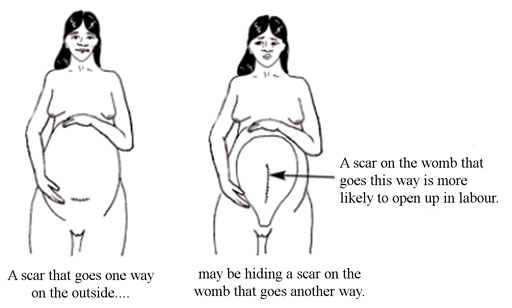Inspection of the abdomen
In order to memorise what aspects to inspect on the abdomen of a woman in labour, you can take the initial 'S' letters of the three points to look out for: size, shape and scars.
- Size: Is the abdomen too big or too small for the gestational age of the fetus? If it is too small, the baby may not have developed properly; if it is too big, the woman may have twins, or a condition called polyhydramnios (too much amniotic fluid). If the abdomen is either too big or too small, refer the mother to a health facility.
- Shape: Does the abdomen have an oval shape (like an egg — a little bit wider at the top of the uterus and narrower at the lower segment)? At near to full term, or in labour, this shape usually indicates that the baby is presenting 'head-down'. If it is round like a ball, it may indicate an abnormal presentation (as you will learn below, and in Study Session 8).
- Scar: Observe if she has a scar from an operation in the lower abdomen, from a previous caesarean delivery (Figure 2.3); the scar will usually be just above her pubic bone; if she has had surgery on her uterus previously, refer her to the nearest health facility. Scarring of the uterus puts her at risk of uterine rupture during the current delivery (as you will learn in Study Session 10).

Figure 2.3 Previous caesarean surgery increases the risk during the next labour.
Last modified: Monday, 14 July 2014, 4:14 PM